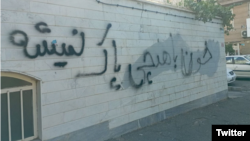
Welcome back to The Farda Briefing, an RFE/RL newsletter that tracks the key issues in Iran and explains why they matter. To subscribe, click here. I'm RFE/RL correspondent Golnaz Esfandiari. Here's what I’ve been following during the past week and what I’m watching for in the days ahead.
The Big Issue
As the authorities intensify their deadly crackdown on antiestablishment protests in Iran, some demonstrators are resorting to protest art to express their dissent. The street art and graffiti has targeted Iran’s clerical regime, including Supreme Leader Ayatollah Ali Khamenei, and has appeared on public walls in major cities.
Most of the graffiti is done at night. Several Tehran residents told me that they often see public walls spray-painted with anti-regime slogans in the morning. By the evening, most of the graffiti is washed off or painted over, they said. The next morning, new graffiti appears, highlighting the tug-of-war between the protesters and the authorities. One prominent message on a wall in Tehran reads: “Blood cannot be cleansed by anything."
Videos and photos posted on social media appear to show that anti-regime graffiti and public art is expanding.
Some of the art depicts Mahsa Amini, the 22-year-old woman whose death soon after being detained by the morality police ignited the nationwide protests. Other murals show the victims of the state’s crackdown on the protests. Some of the graffiti includes slogans such as, “Death to Khamenei” and “Woman, life, freedom.”
Why It Matters: Protesters are finding new and creative ways to express their anger at the clerical establishment, which has responded to the protests with lethal force and mass arrests. Besides resorting to protest art and graffiti, some Iranians have been shouting antiestablishment slogans at night from their rooftops and windows.
What's Next: Acts of civil disobedience are likely to continue and increase in the face of the government clampdown. Such acts allow protesters to sustain the demonstrations without marching on the streets, where they face a greater risk of arrest and harm. The overstretched security forces have found it difficult to stop street art and creative forms of dissent.
Stories You Might Have Missed
- Iran's universities have turned into a major battleground between the protesters and the authorities. Some female students have removed and burned their head scarves. Male and female students have also broken social taboos by holding hands and singing together. Some art students have covered their hands in red paint to protest the state crackdown on the demonstrations. The authorities have cracked down violently on the university protests, beating and detaining dozens of students.
- Russia is increasingly relying on primitive Iranian suicide drones it its attempts to bomb the Ukrainian population into submission, including the cheap but effective Shahed-136 and Shahed-131 "kamikaze" drones. Now, the prospect of Russian forces replenishing their depleted aerial arsenal with powerful Iranian ballistic missiles has officials in Kyiv scrambling for more air cover.
What We're Watching
At least 7,000 people have been detained since the antiestablishment protests erupted on September 17, according to a monitoring group based outside Iran. The vast majority are street protesters, but they also include scores of students, activists, journalists, and artists, the group said. Around 300 minors have also been detained.
In Tehran alone, 315 people have been indicted for participating in the protests, according to the judiciary. The hard-line Fars news agency, affiliated with the powerful Islamic Revolutionary Guards Corps, said four of them have been charged with "waging war against God," which is punishable by death. Fars said about 42 percent of people detained across Iran are below the age of 20, while 48 percent are between 20-35. Interestingly, Fars also reported that 2 percent of detainees are government employees, although it did not offer any details.
Why It Matters: While many of the 7,000 have been released on bail, some remain in detention. There are mounting concerns over their well-being. Rights groups have long documented the inhumane conditions in Iran’s detention facilities and prisons. Political detainees in Iran are often held in solitary confinement for days or weeks while under interrogation, rights groups have said.
That’s all from me for now. Don’t forget to send me any questions, comments, or tips that you have.
Until next time,
Golnaz Esfandiari
If you enjoyed this briefing and don't want to miss the next edition, subscribe here. It will be sent to your inbox every Wednesday.




